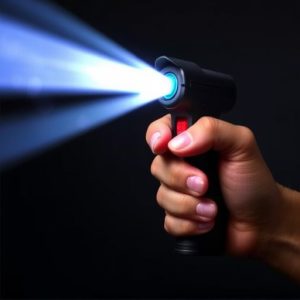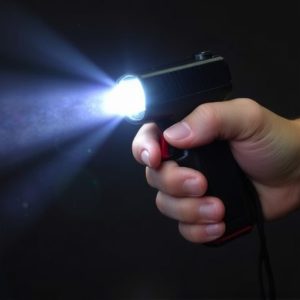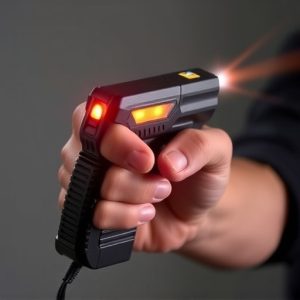Decoding Stun Gun Efficacy: Mechanisms, Factors, and Real-World Self-Defense Outcomes
Stun guns operate by delivering a high-voltage, low-amperage electric shock that incapacitates atta…….
Stun guns operate by delivering a high-voltage, low-amperage electric shock that incapacitates attackers by causing muscle spasms and intense pain. Central to their function is the rechargeable battery, which powers the device's stainless steel probes. The effectiveness of a stun gun depends on its voltage output, amperage, and electrode placement, all of which affect how it disrupts muscle function. Factors like moisture on the target's skin, environmental humidity, and ambient temperature can influence the device's performance, necessitating an understanding of optimal conditions for use. Proper training is crucial as it involves not just handling the stun gun but also timing deployment with situational awareness to ensure safety and effectiveness in self-defense scenarios. Legal restrictions vary by jurisdiction, so users must be aware of local laws. Understanding how a stun gun works, including its limitations and optimal use, is essential for effective self-defense and deterring violence.
When considering personal safety devices, the effectiveness of stun guns emerges as a critical aspect for potential users. This article delves into the mechanisms and components that constitute stun guns, shedding light on how they operate to incapacitate an assailant. We will explore the factors that enhance their efficacy, including design features and user proficiency. Furthermore, real-world scenarios where stun guns have been pivotal in self-defense situations will be examined to provide a comprehensive understanding of their performance and reliability as a non-lethal deterrent. Join us as we unravel the intricacies of stun gun effectiveness.
Understanding Stun Guns: Mechanisms and Components
Stun guns are non-lethal self-defense tools that incapacitate an assailant by delivering a high-voltage, low-current electric shock. To effectively understand how a stun gun operates, one must explore its fundamental components and mechanisms. At the heart of a stun gun is its power source, typically a rechargeable battery, which stores the electrical energy required to produce the shock. This energy is conducted through two conductive probes or prongs, often made from stainless steel for durability and conductivity. The probes are usually placed at opposite ends of the device, creating an electric field between them.
Upon contact with an attacker, the stun gun administers a shock that disrupts the normal function of the skeletal and cardiac muscle in the human body. This interruption of muscle function leads to neuromuscular incapacitation, causing involuntary muscle contractions and intense pain, effectively immobilizing the target. The effectiveness of a stun gun is contingent on various factors, including the voltage output, amperage, and the electrode configuration. Manufacturers design stun guns with safety features to prevent accidental discharges, ensuring they are employed for self-defense purposes only when necessary. Users should be well-versed in the proper use of these devices to ensure their effectiveness during critical situations.
Factors Influencing the Effectiveness of Stun Guns
Stun guns, also known as electronic control devices, are non-lethal weapons designed to incapacitate an adversary through the delivery of an electric shock. Their effectiveness is influenced by several factors that affect their performance and reliability in real-world scenarios. Understanding how a stun gun works provides insight into these variables. The device typically consists of two electrodes connected to a power source, which, upon activation, generate a high-voltage, low-current electrical discharge. This discharge causes muscle contractions and disorientation in the target individual, rendering them temporarily incapacitated.
The effectiveness of stun guns is contingent upon factors such as battery strength, electrode design, and the specific conductive materials used. A fully charged battery ensures a stronger and more reliable shock, while the configuration and positioning of electrodes play a critical role in the delivery of the current. The type of fabric or material between the target and the probes can also affect the stun gun’s efficacy; moisture can enhance conductivity, potentially increasing the shock’s intensity and range. Additionally, environmental factors like humidity and temperature can influence the device’s performance. Users must consider these aspects when assessing the reliability of a stun gun in self-defense situations. Proper training and understanding the limitations and optimal conditions for use are essential to ensure that the device operates as intended when faced with an actual threat.
Real-World Application and Performance of Stun Guns in Self-Defense Situations
Stun guns serve as a non-lethal means of self-defense, delivering electrical shocks to temporarily incapacitate an attacker. Their effectiveness in real-world situations hinges on various factors, including design, user proficiency, and the specific circumstances of the encounter. How does a stun gun work? It typically utilizes a conductive probe or drives with an electric current that, upon contact with an individual, disrupts the normal function of muscle tissue, causing involuntary muscle contractions and disorientation. This response can provide a critical window for escape or to alert authorities. In self-defense scenarios, stun guns can be particularly effective due to their ability to neutralize threats without causing permanent injury. Users must understand that the efficiency of a stun gun is not solely dependent on its voltage or amperage but also on accurate deployment and situational awareness. A stun gun’s performance in self-defense situations is influenced by the element of surprise, the attacker’s physical condition, and environmental factors like weather and terrain. Proper training with a stun gun ensures users can effectively deploy it during an altercation, maximizing its effectiveness as a deterrent against violence. It’s also crucial to be aware of local laws and regulations governing the use of stun guns for self-defense, as these can vary by jurisdiction and significantly impact how and when they can be legally used.


